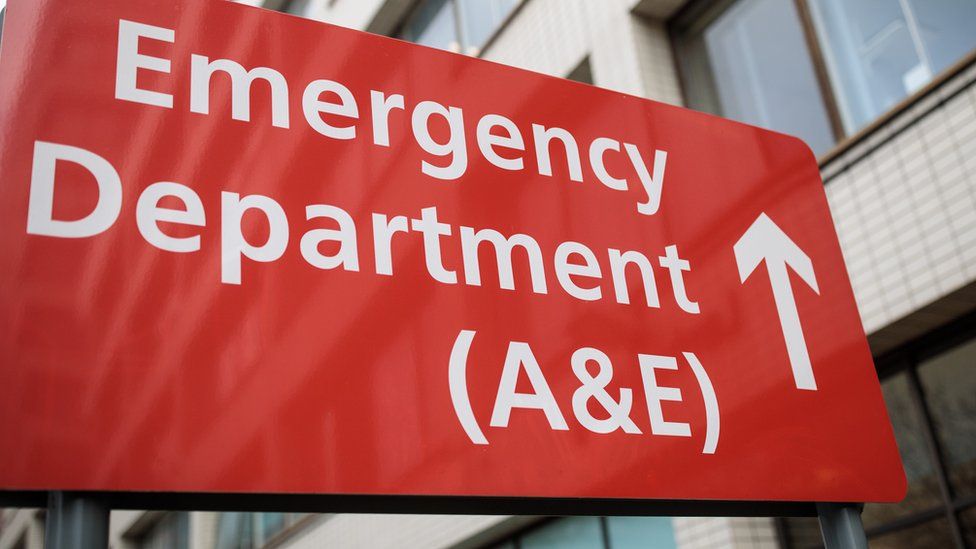30 minutes ago
About sharing
The number of patients waiting more than 12 hours for a bed on a ward after being seen in A&E in England was 19 times higher this winter than it was before the pandemic, figures show.
There were nearly 100,000 12-hour waits in December and January – compared to just over 5,000 in 2019-20.
A decade ago these waits were virtually unheard of – in the four winters up to 2013-14 there were fewer than 100.
The King’s Fund said long delays were at risk of becoming normalised.
It said the pressures this winter had received little attention compared to last winter, despite no significant improvement in performance.
How are your local NHS services coping this winter?
Enter a postcode to find out. Eg ‘B1 1RF’
Last updated: Thursday 8 February
About the data
Data for England is shown by NHS trust, where the trust includes at least one hospital with a Type 1 A&E department. Type 1 means a consultant-led 24 hour A&E service with full resuscitation facilities. Data for Wales and Scotland is shown by Health Board and in Northern Ireland by Health and Social Care Trust.
When you enter a postcode for a location in England you will be shown a list of NHS trusts in your area. They will not necessarily be in order of your closest hospital as some trusts have more than one hospital. Data for Wales and Scotland are shown by NHS board and by Health and Social Care trust in Northern Ireland.
Comparative data is shown for a previous year where available. However, where trusts have merged there is no like-for-like comparison to show. Earlier data is not available for all measures, so comparisons between years are not always possible.
In England and Northern Ireland A&E attendances include all emergency departments in that trust or health board, not just major A&E departments. For example, those who attend minor injury units are included. In Wales the data include all emergency departments, but does not include patients kept in A&E by doctors under special circumstances, [more details here](https://www.bbc.co.uk/news/uk-wales-67056279). In Scotland the data includes only major A&E departments.
Each nation has different target times and definitions for some of the measures shown, therefore comparisons between them are not possible.
A modern browser with JavaScript and a stable internet connection are required to view this interactive.
During December 2023 and January 2024, 98,300 patients waited more than 12 hours for a bed on a ward after A&E doctors took the decision to admit them.
These tend to be the sickest and frailest patient – and this wait comes after they have already waited to be seen in the first place after arriving at A&E.
Delays waiting to be seen in A&E are also much worse than they were before the pandemic – more than 30% of patients have waited over four hours over the past two months.
One of those who has faced a long wait this winter is Alasdair Duncan, 32, from the West Midlands. He spent 23 hours in A&E after going in with a heart issue before being admitted on to a ward.
He said the hospital was “cripplingly understaffed”.
“It was a long wait. You just see how stretched everything is. There were clearly a lot of people struggling to get care.”
He was discharged after tests ruled out any concerning, ongoing heart problems.
Other parts of the UK are also struggling. Data is only available up to the end of December, but it shows Northern Ireland has the worst performance, with 60% of patients waiting over four hours.
The Northern Ireland branch of the Royal College of Emergency Medicine said the pressures were “unsurmountable” and it was having a detrimental impact on patients.
On waits in England, RCEM vice president Dr Ian Higginson said measures put in place by the government and NHS England – which including opening 5,000 extra hospital beds and creating 10,000 virtual beds whereby patients with respiratory and heart conditions get extra care in the community to keep them out of hospital – had failed to have much of an impact.
He said hospitals were over-crowded and just as unsafe, if not more unsafe, than last year.
“The plans have made little real difference to the experience of patients,” he said.
Saoirse Mallorie, a senior analyst at The King’s Fund, said while the pressures on the NHS have not had as much attention as last year the situation was very similar.
“We are at risk of normalising incredibly poor performance,” she said.
NHS England medical director Prof Sir Stephen Powis said the NHS had been under significant pressure this winter describing it as “one of the busiest winters ever” – and that was continuing into February.
He pointed out the number of patients in hospital with flu was particularly high.
But he said the “robust measures” put in place had helped.
Related Topics
17 January
54 minutes ago
